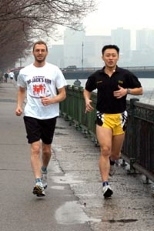UPDATE April 20, 2004: Ken Ross finished the Boston Marathon in 3:13, maintaining a pace of just over seven minutes per mile in difficult weather conditions. Temperature at the finish line was 85 degrees, with a 25 mph wind and 50 percent humidity. He came in 172nd in his division and 734th overall in a race with 20,344 runners. Timothy Cherigat of Kenya won the men's race in 2:10:37.
-------------------------
April 16, 2004 -- A lot of runners want a piece of the action Monday. But for at least one MIT runner, the marathon is just that -- a piece of the action, not the whole show.
Ken Ross, a computational biologist at the Broad Institute who will run as #4397 in the Boston Marathon on April 19, is a member of MIT's Triathlon Club, a group of about 30 men and women -- students, faculty and staff -- who prefer their marathons as the last leg of a three-pronged race.
Okay, not all triathlons involve a full marathon. Only the "ultra" triathlon competitions (better known as Ironman triathlons) require a 2.4-mile swim, followed by 112 miles of cycling and finally the 26.2-mile run. But even the shorter triathlons require athletes to be in such tip-top shape that a 26.2-mile run isn't quite as grueling as one might imagine.
So, of course, Ross doesn't expect to be totally wiped out by the marathon. ("I usually feel reasonably good. I mean I'm very tired and happy, but there's a sense of euphoria," he said.) In fact, he plans to walk home afterwards (he lives in the South End) and have some dinner to celebrate. While he doesn't expect to be a top finisher even with his hometown advantage, he does hope to break his own record and run from Hopkinton to Beacon Street in a time of 2:50.
He'll take up his training again later that week.
Sounds a little like a wise guy, eh? Nope. This 42-year-old scientist is anything but. He's a shy, soft-spoken guy who does woodcarving in the remainder of his spare time. And at 5'9" and 140 pounds, his lean frame looks about a decade younger than his years, much like his teammate, graduate student Harn Wei Kua.
The 32-year-old Kua, an architecture student who does research on sustainable building materials in MIT's Building Technology Program, could easily pass as an undergrad. And no wonder -- he must have one of the most finely tuned engines in the world. He's ranked eighth in the world in the Double Ultra Triathlon.
It defies the imagination, but the Double Ultra actually doubles all the distances of the "regular" ultra triathlon.
Last September in Lithuania, Kua swam 4.8 miles, cycled 224 miles in the rain and then discovered his running shoes had been stolen. So he grabbed his trainers ("What could I do?" he said) and ran 52.4 miles. The competition -- which began at 1 p.m. -- took him 27 hours of continuous motion. A Frenchman won it in 23 hours.
"After more than 10 hours of continuous activity, your adrenalin is flowing so you don't feel as exhausted as you should be, and certainly not tired," Kua said of the 52.4-mile run.
"I try to respond to the crowd -- the cheering or waving or even laughing. During the night you get another species of supporters. They're usually partiers who are drunk. Sometimes they raise their beer bottles to me as I go by," he said with a laugh.
Kua described his move into the Double Ultras as "natural."
"I'd been doing the Ironman stuff for a couple of years now, so it was natural for me to step up to the next level," said the native of Singapore, an island country about 30 miles wide.
He and several other MIT community members founded the MIT Triathlon Club in February 2001. They meet for training sessions in the Zesiger Center, for a one-hour swim three times a week, for example. The members describe the club as a "competitive, recreational and social organization in the sport of triathlon. Our primary goal is to provide a network of information, support, camaraderie, training and racing activities for athletes of all skill levels in the MIT community," according to the club's web site.
"My personality is to push myself and test my limits," said Ross. For him and Kua, the exertion provides a peace akin to that found in meditation.
"I try to keep my thoughts free, just let it flow and feel the peace. You get into a zone and feel at peace with yourself," said Kua.
"It's a very meditative time for me," said Ross. "Whatever comes in my mind then just floats in and out of my head."
It still doesn't quite explain why they're driven to this ultra sport. But admiration doesn't require understanding.
For more information about the MIT Triathlon Club, contact the club's president Jorge Carretero at jorgcb@mit.edu or see the web site).






